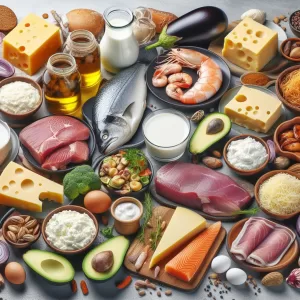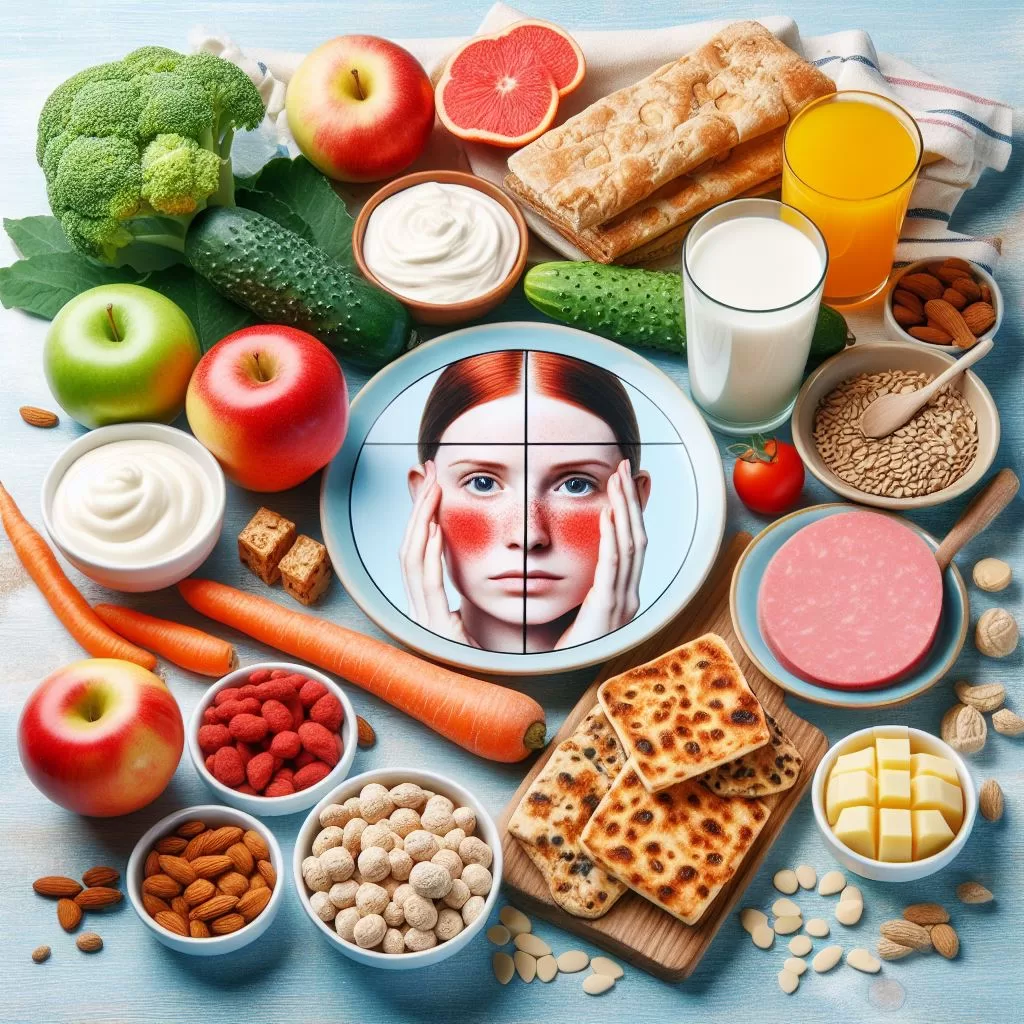Rosacea, with its characteristic redness and irritation, poses a daily challenge to those who suffer from it. While the link between diet and rosacea is complex, it is undeniable that certain foods can worsen symptoms, while others seem to soothe them.
This article dives directly to the heart of the subject by identifying precisely which foods to avoid and which dietary strategies to adopt to fight against rosacea. By understanding how your diet influences your skin, you can take concrete steps to minimize rosacea symptoms and improve your quality of life.
I. Foods to Avoid for People With Rosacea:
1. Spicy Foods:

Spicy foods play a significant role in triggering rosacea symptoms for several reasons. The active ingredient in many spices, including chili peppers, is capsaicin, which can cause blood vessels to dilate. This reaction causes increased blood flow to the skin’s surface, which can exacerbate the redness and breakouts associated with rosacea.
Spices aren’t limited to chili peppers; other strong spices like black pepper and mustard can also contribute to these reactions. The thermogenic effect of spicy foods, which increases body temperature, may also play a role in intensifying rosacea symptoms. People with this condition are advised to monitor their reaction to eating spicy foods and adjust their diet accordingly to avoid or minimize flare-ups.
Managing food triggers, including limiting or eliminating spicy foods are therefore an important strategy for people with rosacea. This can help reduce the frequency and severity of flare-ups, improving quality of life.
2. Hot drinks:

Hot beverages, such as coffee, tea, and hot chocolate, can be triggers for rosacea due to the effect of heat on the body. When you consume a hot beverage, the high temperature can cause vasodilation or expansion of the blood vessels. This reaction can lead to increased facial redness, a common symptom of rosacea. The heat from drinks can also contribute to a burning or tingling sensation, exacerbating the feeling of discomfort in people with this condition.
For people with rosacea, it is advisable to pay attention to the temperature of the drinks they consume. Opting for warm or cold drinks can help reduce the risk of triggering or worsening rosacea symptoms. Managing heat exposure in general, whether through hot drinks, hot baths, or exposure to high temperatures, is an important strategy for controlling rosacea symptoms.
If you are affected by rosacea, it is a good idea to monitor the temperature of the drinks you consume and try to favor cooler options to help keep symptoms under control.
3. Alcohol:

Drinking alcohol can make rosacea symptoms worse, especially because alcohol dilates blood vessels, increasing redness and hot sensations on the face. Alcoholic beverages, especially red wine, are known to trigger flare-ups in sufferers. It is therefore advisable to limit or avoid alcohol to reduce the frequency and intensity of these symptoms.
4. Dairy Products:

Dairy products, such as yogurt, cream, and cheese, can be triggers for people with rosacea. They are known to be potential sources of inflammation, which can worsen rosacea symptoms, such as facial redness and swelling. For some people, reducing dairy consumption or switching to non-dairy alternatives, such as rice, almond, or soy milk, can help alleviate these symptoms.
If you suspect dairy triggers or worsens your rosacea, consider reducing or eliminating it from your diet to see if that brings improvement. However, it is always recommended to consult a dermatologist or nutritionist for personalized advice tailored to your specific situation.
5. Foods Rich in Histamine:

Foods high in histamine may play a significant role in triggering or worsening rosacea symptoms in susceptible individuals. Histamine is a chemical that, when present in large quantities in the body or introduced through food, can cause dilation of blood vessels. This reaction can then cause or intensify the redness and inflammation characteristic of rosacea.
Foods known to be high in histamine include aged cheeses, fermented products like yogurt and sauerkraut, smoked meats, certain fish, avocados, eggplant and shellfish. Additionally, foods like bananas, citrus fruits, tomatoes, and nuts may not be high in histamine themselves but can trigger the body to release histamine, contributing to the onset of symptoms.
For people with rosacea who are sensitive to histamine, it may be beneficial to limit or avoid these foods and observe whether symptoms improve. It is also advisable to consider individual sensitivity factors, as the reaction to foods high in histamine can vary from person to person. Keeping a food diary can be a useful tool for identifying specific foods that trigger or exacerbate rosacea symptoms.
With severe histamine sensitivity, some people find relief by taking antihistamines before a histamine-rich meal to ease side effects, although it is important to consult a healthcare professional before taking this approach.
6. Sugar and High Glycemic Index Foods:

Sugar and high-glycemic foods can worsen rosacea symptoms by causing systemic inflammation in the body. When sugar is consumed in excess, it can lead to overproduction of insulin, which in turn can increase inflammation and potentially trigger rosacea flare-ups.
Eating foods high in sugar and high on the glycemic index can accelerate aging, influence weight gain, and harm brain and heart health. These foods also promote inflammatory conditions in the body, which could exacerbate rosacea symptoms. To better manage rosacea, it is suggested to reduce the consumption of such foods, instead favoring those with a low glycemic index for a more stable energy release.
7. Highly Acidic Foods:

Eating highly acidic foods is one such factor that can exacerbate rosacea symptoms in some people. This category of foods includes, among others, tomatoes, citrus fruits (such as oranges, lemons, and grapefruit), and vinegar.
The impact of these foods on rosacea can be attributed to their acidity. When these foods are consumed, they can potentially disrupt the skin’s natural pH balance. Human skin normally has a slightly acidic pH, which plays a crucial role in protecting against pathogenic bacteria and preserving the skin barrier. Eating highly acidic foods can alter this delicate balance, making the skin more susceptible to inflammation and irritation.
Additionally, acidity can stimulate an inflammatory response in the body, exacerbating rosacea symptoms. This can result in increased redness, spots, and visibility of blood vessels, characteristic symptoms of this condition.
8. Processed Meats:

Processed meats, such as sausages, bacon, cured meats, and smoked meats, are common items in many diets. However, for people with rosacea, these products may pose a risk of exacerbation of symptoms. The presence of sulfites, nitrates, nitrites, and other preservatives in these processed meats is often blamed for their pro-inflammatory effects, which can worsen the skin condition in sensitive individuals. Examining the impact of these foods in detail to minimize their effect can help manage rosacea symptoms more effectively.
■ Impact of Processed Meats on Rosacea:
- Sulphites and Preservatives:
Sulfites, commonly used as preservatives in processed meats, are known to cause inflammatory reactions in some people. These reactions can exacerbate rosacea symptoms, leading to increased redness and inflammation of the skin.
- Nitrates and Nitrites:
These compounds can convert into nitrosamines in the body, substances that have been linked to increased inflammation and other health problems. Systemic inflammation can affect the skin and worsen conditions such as rosacea.
- Imbalance of the Intestinal Microbiome:
Regular consumption of processed meats can disrupt the balance of the gut microbiome. Given the important connection between gut health and skin health, this effect may indirectly contribute to the worsening of rosacea.
Favor lean, unprocessed meats, such as chicken, turkey, or lean cuts of beef, which do not contain added sulfites or nitrates.
9. Food Additives:

The relationship between food additives and rosacea is a growing concern for many people suffering from this skin condition. Rosacea is a chronic inflammatory skin disease that manifests itself with redness, pustules, visible blood vessels, and sometimes thickening of the skin, mainly on the face. Although the exact causes of rosacea remain partially unknown, research suggests that certain factors, including food additives, may worsen its symptoms.
■ Understanding Food Additives:
Food additives are substances added to food to improve aspects such as taste, texture, durability, and appearance. Among these additives, some are particularly scrutinized for their potential negative impact on rosacea:
- Monosodium Glutamate (MSG):
Used as a flavor enhancer in many processed foods and some restaurants, MSG can cause inflammatory reactions in sensitive people, exacerbating rosacea symptoms.
- Artificial Colors:
Often used to make foods more appealing, artificial colors can also trigger inflammatory reactions in some individuals.
- Conservatives:
These substances, intended to extend the life of food products, can also be aggravating factors for people with rosacea, due to their inflammatory potential.
■ Tips:
- Read the Labels Carefully:
This helps identify and avoid foods with additives that may make rosacea worse.
- Favor Natural Foods:
Opting for a diet rich in fruits, vegetables, and unprocessed foods can help reduce exposure to food additives.
Food additives can be triggers for rosacea symptoms in some people. A proactive approach to dietary management, focused on reducing exposure to these substances, can significantly contribute to improving the quality of life of those affected.
10. Nuts:

Nuts, known for their many health benefits, such as providing essential fatty acids, protein, fiber, vitamins, and minerals, can nevertheless pose a challenge for those suffering from rosacea. For a significant number of individuals, the consumption of walnuts, almonds, hazelnuts, and other tree nuts can trigger or exacerbate the symptoms of this skin condition. Examining the interaction between nuts and rosacea help manage their impact and can help navigate this complexity while maintaining a nutritious diet.
Why Can Nuts Affect Rosacea?
- Inflammatory Reactions:
Although nuts contain anti-inflammatory fatty acids, like omega-3, they can also cause inflammatory reactions in some people, exacerbating rosacea symptoms.
- Allergies and Sensitivities:
Nut allergies or sensitivities are common and can not only cause typical allergy reactions but also activate or worsen rosacea in sensitive individuals.
- Histamine:
Some nuts may release or contain histamine, which can worsen rosacea symptoms for those with histamine sensitivity because it contributes to inflammation and dilation of blood vessels.
If nuts aggravate your rosacea, consider alternative sources of essential nutrients. Seeds, such as chia, flax, and pumpkin seeds, can offer a nutritious alternative without the unwanted effects.
11. Fatty and Fried Foods:

Fatty and fried foods can impact rosacea and other skin conditions in several ways, primarily by exacerbating inflammatory symptoms. Although the exact mechanisms vary and may depend on individual sensitivity.
Here is how these foods can influence rosacea:
- Inflammation :
Foods high in saturated and processed fats, typical of fried and fatty products, can stimulate inflammatory processes in the body. Inflammation is a key factor in rosacea flare-ups because it can worsen the redness and spots associated with this condition. Omega-6 fatty acids, present in large quantities in oils used for frying, are particularly known for their pro-inflammatory role when consumed in excess compared to anti-inflammatory omega-3 fatty acids.
- Effects on the intestinal microbiome:
There is a significant connection between gut health and skin health, often referred to as the gut-skin axis. A diet high in fat and fried foods can disrupt the balance of the gut microbiome, promoting the growth of bacteria that can trigger inflammation throughout the body, including the skin. This can exacerbate rosacea symptoms in some people.
- Increase in body temperature:
Eating very hot foods, including those that are fried, can cause a temporary increase in body temperature. For people with rosacea, this temperature rise can trigger flushing (intense redness) because it stimulates blood vessels to expand, making rosacea symptoms worse.
- Effects on blood sugar levels:
Fried foods are often high in simple carbohydrates which can cause rapid spikes in blood sugar. These fluctuations can stimulate a cascade of hormonal reactions that promote inflammation and can impact rosacea.
12. Cinnamon and Other Hot Spices:

Cinnamon and other hot spices, such as chili, ginger, and pepper, play an important role in global cuisine, bringing flavor and depth to many dishes. However, for people with rosacea, these spices can sometimes act as triggers, exacerbating the symptoms of this skin condition. Understanding the impact of these spices on rosacea and how to manage them can help minimize their effect while maintaining a balanced, flavorful diet.
■ How do Cinnamon and Hot Spices affect Rosacea?
- Stimulation of Blood Circulation:
Hot spices can stimulate blood circulation and cause blood vessels to dilate. For people with rosacea, this can lead to increased redness and flushing of the skin.
- Inflammatory Effect:
Although some spices have anti-inflammatory properties, their “hot” nature can trigger an inflammatory response in some people, making rosacea symptoms worse.
- Allergic or Sensitivity Reaction:
Some people may have a specific sensitivity or allergy to certain spices, including cinnamon, which may manifest as an exacerbation of their rosacea.
II. Strategies for Identifying Your Triggers:
Since food triggers vary from person to person, identifying yours may require a methodical approach.
Here are some strategies:
1. Gradual Introduction of Foods:
Gradually introducing foods is an effective strategy for identifying dietary triggers, particularly for conditions such as rosacea, where certain foods can exacerbate symptoms. This method requires patience and precision, but it can provide valuable information about how your body reacts to different foods.
– Keep a food diary:
Before you even begin reintroducing foods, it is crucial to keep a food diary. Write down everything you eat and drink, as well as the time and symptoms you experience afterward. This will help you identify patterns and make it easier to isolate suspicious foods.
– Choose a food to test:
From your journal, identify a food that you suspect is a potential trigger. It is important to choose only one food at a time to test. This ensures that you can attribute any changes in your symptoms to that specific food.
– Plan the reintroduction:
Reintroduction must be planned carefully. Start with a small amount of the food in question and gradually increase the portion over the days if no symptoms appear. For example, if you are experimenting with dairy products, you can start with a teaspoon of yogurt and see the effects for 24 to 48 hours.
– Observe and note:
During the reintroduction phase, continue to keep your food diary in as much detail as possible. Note not only your consumption of the food tested but also any variations in your rosacea symptoms. This includes any redness, inflammation, or burning sensation.
– Evaluate the results:
After reintroducing the food and observing the effects for several days, evaluate the results. If your symptoms have gotten worse, this may indicate that the food is indeed a trigger for you. If no changes are observed, the food may not affect your rosacea, or at least not significantly.
Gradual reintroduction of foods is a valuable method for identifying specific dietary triggers for rosacea. By taking a methodical approach and carefully documenting the process, you can gain valuable insights into how your body reacts to certain foods. This will allow you to better manage your condition and live a more comfortable, worry-free life.
2. Food Diversification:
Dietary diversification plays a crucial role in maintaining a healthy and balanced diet. It involves introducing a wide variety of foods into your daily diet, not only to break the monotony of meals but also to optimize your intake of essential nutrients. Indeed, each food provides its own set of vitamins, minerals, antioxidants, and other health-promoting compounds, which together help strengthen the immune system, improve digestive health, and support bodily functions.
■ Benefits of dietary diversification:
- Balanced nutrient intake:
By consuming a wide range of foods, you increase your chances of meeting all your nutritional needs without resorting to supplements. For example, green leafy vegetables are rich in vitamin K and iron, while colorful fruits provide an abundance of antioxidants and vitamin C.
- Prevention of dietary deficiencies:
A varied diet reduces the risk of specific nutrient deficiencies, which can prevent many health conditions.
- Discovery of new flavors:
Experimenting with different foods can enrich your cooking experience, introducing you to new flavors and textures.
- Dietary adaptation:
Diversification helps identify the foods that are best for you. It is particularly useful for people with food allergies, intolerances, or certain chronic illnesses.
- Minimization of risks linked to toxins:
Varying food sources can also dilute the potentially harmful effects of some toxins found naturally in certain foods.
■ Strategies for successful dietary diversification:
- Include all food categories:
Be sure to include fruits, vegetables, proteins (plant and animal), whole grains, legumes, nuts and seeds.
- Vary the colors:
Try incorporating a color palette into your plates. Each color of food represents a different set of antioxidants and nutrients.
- Experiment with world cuisines:
International cuisines can offer unique combinations of ingredients and preparation methods that enrich your diet.
- Plan meals:
Planning helps to intentionally incorporate a variety of foods throughout the week.
- Read the labels:
Be careful about the products you buy. Opt for foods with few additives and preservatives for a healthier diet.
By applying these principles of dietary diversification, you not only promote a balanced and nutritious diet, but you also create a rich and varied food environment that can contribute to better overall health.
3. Anti-Inflammatory Diet:
Anti-inflammatory eating is an increasingly popular concept in the health and wellness world, aimed at reducing inflammation in the body through a carefully selected diet.
This approach may be particularly beneficial for people suffering from chronic inflammatory conditions, such as rosacea, arthritis, and various autoimmune diseases. By incorporating foods with anti-inflammatory properties, it is possible to control, or even reduce, inflammation and its associated symptoms.
■ Why choose an anti-inflammatory diet?
Inflammation is a natural response of the immune system to injury or infection. However, chronic inflammation can lead to various chronic diseases.
A diet rich in anti-inflammatory foods can help:
– Reduce the risk of chronic diseases.
– Improve overall health and well-being.
– Reduce pain and symptoms associated with inflammation.
■ Key foods in an anti-inflammatory diet:
- Berries :
Strawberries, blueberries, raspberries, and blackberries are loaded with antioxidants, called anthocyanins, which have anti-inflammatory effects.
- The green vegetables :
Spinach, kale, and broccoli contain high levels of vitamins and minerals, such as vitamin E, which can help protect the body against pro-inflammatory cytokines.
- Oily fish:
Salmon, mackerel, sardines, and herring are rich in omega-3 fatty acids known for their anti-inflammatory properties.
- Nuts :
Almonds, walnuts, and other varieties are not only a great source of protein, but they also contain healthy fatty acids, antioxidants, and fiber, helping to reduce inflammation.
■ Tips for an effective anti-inflammatory diet:
- Vary your consumption:
To benefit as much as possible from the anti-inflammatory properties of foods, it is important to vary the types of foods consumed.
- Incorporate spices:
Turmeric and ginger, among others, are known for their powerful anti-inflammatory properties.
- Reduce the consumption of pro-inflammatory foods:
Limit processed foods, refined sugars, and vegetable oils rich in omega-6, which can promote inflammation.
- Favor whole foods:
Foods in their most natural form often contain a synergy of nutrients that work together to support health.
- Hydrate yourself:
Water plays a key role in reducing inflammation, helping to flush toxins from the body, and keeping cells healthy.
By incorporating these principles and foods into your daily diet, you can not only improve your overall health but also significantly reduce symptoms related to inflammatory conditions. It is always recommended to consult a healthcare professional or nutritionist to tailor this advice to your specific needs and health situation.
4. Following a Hypoallergenic Diet:
Following a hypoallergenic diet is a key dietary strategy for people with inflammatory disorders, food allergies, or sensitivities that can affect their well-being, such as rosacea. This method primarily involves eliminating products known to be common triggers of allergies or inflammatory reactions from the diet, then reintroducing them one by one to identify problem foods. This approach can be particularly useful in discovering individual specificities in food tolerance and adjusting the diet accordingly to minimize symptoms.
■ Why adopt a hypoallergenic diet?
- Identification of food triggers:
Allows you to determine which foods cause bad reactions to avoid them.
- Reduced inflammation and allergic symptoms:
Helps relieve symptoms related to various conditions, including rosacea, digestive disorders, and food allergies.
- Diet Personalization:
Provides a deeper understanding of your body’s unique needs, enabling more targeted nutrition for your health.
■ Foods commonly excluded in a hypoallergenic diet Foods frequently eliminated in a hypoallergenic diet include, but are not limited to:
- Dairy products :
Often removed due to lactose and milk proteins which can cause reactions.
- Gluten:
Present in wheat, barley, and rye, gluten is excluded when testing for gluten sensitivity or intolerance.
- Eggs:
Eliminated due to their high allergenic potential.
- Soy:
Another common allergen, soy is often removed.
- Nuts and peanuts:
Excluded for their allergic potential.
- Fish and shellfish:
May cause allergic reactions in some people.
- Additives and preservatives:
Some, such as monosodium glutamate (MSG) and artificial colors, are removed due to their potential role in allergic and inflammatory reactions.
■ Food reintroduction procedure:
After a period of elimination (usually a few weeks to a few months), foods are reintroduced gradually, one at a time, while monitoring symptoms. This step is crucial for identifying specific foods that cause reactions.
Here’s how to do it:
- Choose a food to reintroduce:
Start with a single food or food group.
- Introduce this food:
Consume it in small quantities at first, then gradually increase over several days.
- Observe and record:
Pay attention to any reactions or changes in your symptoms. This includes skin, digestive, respiratory, or other reactions.
- Wait before reintroducing a new food:
If no symptoms appear, you can consider this food safe for you. Wait a few days without symptoms before trying a new food.
By following these steps and tips, the hypoallergenic diet can become a powerful tool for identifying foods that exacerbate the symptoms of conditions like rosacea, allowing for more effective management through diet.
5. Avoidance of Sudden Changes in Food Temperature:
Avoiding sudden changes in food temperature is an often overlooked but potentially effective strategy for people with food sensitivities, digestive disorders, or skin conditions like rosacea. Eating very hot or very cold foods in rapid succession can cause a bodily reaction, sometimes intense, which manifests itself in unpleasant symptoms in some people. Understanding this dynamic and adjusting the temperature of foods consumed may prove to be a simple but beneficial approach to managing and potentially reducing associated symptoms.
■ Why do sudden changes in food temperature affect certain individuals?
- Vascular response:
Extreme temperatures, whether hot or cold, can cause rapid dilation or contraction of blood vessels. In sensitive people, this can lead to redness, itching, or even flare-ups of pre-existing conditions like rosacea.
- Thermal shock:
The rapid change from hot to cold (or vice versa) can disrupt the digestive system, sometimes leading to abdominal pain, bloating, or other uncomfortable digestive symptoms.
- Activation of the nervous system:
Sudden temperature changes can stimulate the nervous system in unexpected ways, which can worsen certain symptoms in predisposed individuals.
■ Tips for managing food temperature changes:
- Eat foods at moderate temperatures:
Try to let very hot foods cool and slightly warm very cold foods before consuming them. This can help minimize your body’s reaction to temperature extremes.
- Introduce gradual transitions:
If you want to consume a hot food followed by a cold food (or vice versa), introduce a room temperature transition in between to give your body time to adjust.
- Listen to your body:
Pay attention to the signs your body sends you after eating foods at different temperatures. If you notice recurring symptoms, it may be wise to change your approach.
- Adapt your environment:
Besides the temperature of the food, be aware of your general environment. Avoiding sudden changes in ambient temperature can also help reduce symptoms.
- Consult a professional:
if changes in food temperature regularly cause symptoms, discuss it with a healthcare professional. They can offer personalized advice and help identify other contributing factors.
6. Adopting a Low FODMAP Diet:
This type of diet helps reduce or avoid bloating, pain, and other unpleasant digestive symptoms in some people. Surprisingly, there are links between gastrointestinal health and skin conditions, like rosacea.
A low FODMAP diet might also help reduce symptoms of certain skin conditions by improving gut health.
■ Understanding FODMAPs:
FODMAPs include:
- Fermentable:
Rapidly fermented by intestinal bacteria.
- Oligosaccharides:
Present in foods such as wheat, onion, and garlic.
- Disaccharides:
Lactose is the main disaccharide concerned, found in dairy products.
- Monosaccharides:
Excess fructose, present in certain fruits and honey.
- Polyols:
Sugar alcohols found in some fruits, vegetables, and artificial sweeteners.
■ Benefits of a low FODMAP diet:
- Reduction of digestive symptoms:
Reduces bloating, gas, abdominal pain, and intestinal irregularities.
- Improved quality of life:
By reducing gastrointestinal symptoms, individuals can experience a significant improvement in their daily well-being.
- Identification of food sensitivities:
Allows individuals to identify the specific foods that trigger their symptoms, thus promoting a more personalized diet.
■ Implementing a low FODMAP diet:
- Elimination phase:
Start by eliminating all high FODMAP foods from your diet for 4 to 6 weeks.
- Reintroduction phase:
Gradually reintroduce foods containing FODMAPs into your diet, one group at a time, to identify the foods that trigger your symptoms.
- Personalization phase:
Adapt your diet based on the foods you can tolerate, avoiding those that exacerbate your symptoms.
■ Foods to avoid and favor:
- Avoid:
Certain fruits like apples and mangoes, dairy products high in lactose, legumes, wheat, and artificial sweeteners like sorbitol.
- Preferably:
Meats, fish, eggs, certain cheeses such as cheddar and parmesan, low FODMAP fruits and vegetables such as oranges and carrots, and gluten-free grains.
■ Tips for success:
- Consult a dietitian:
A dietitian can help you navigate the diet and ensure you maintain a balanced diet.
- Keep a food diary:
Write down what you eat and how you feel afterward to identify links between foods and symptoms.
- Plan your meals:
Planning can help avoid the pitfalls of limited food options when going out or in unforeseen situations.
Understanding and avoiding your food triggers can play a key role in managing rosacea. By taking a mindful approach and adjusting your diet, you can reduce breakouts and maintain healthier skin.
Conclusion:
Navigating the maze of dietary recommendations can seem daunting for those battling rosacea. However, by identifying and avoiding trigger foods, choosing a diet rich in anti-inflammatory nutrients, and adopting healthy eating habits, you can exert significant control over rosacea symptoms. As each individual is unique, it is essential to observe how your body reacts and adjust your diet accordingly. Commitment to a personalized dietary plan, coupled with proper skincare and regular consultation with healthcare professionals, can pave the way to a life less affected by rosacea. Embrace this integrated approach and take one step closer to healthier, happier skin.

